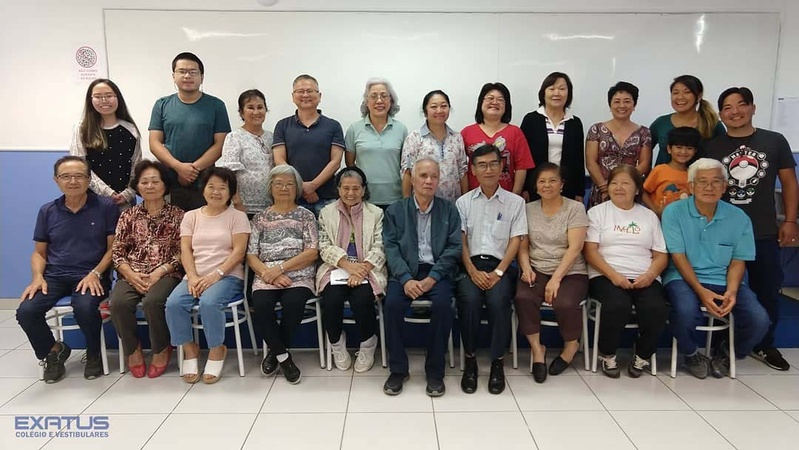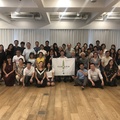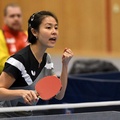Okinawa culture marks its presence in Sao Paulo city, Brazil, through activities and events organized by the local associations. Music, dance, and cooking are the main elements used to promote it.
These events usually attract many visitors, who gradually come into contact with words slightly different from the ones of the “Japanese language.” “Uchina”, “mensore,” and “goya” are words often heard or read in a typical event hosted by the Okinawa descendant community in Sao Paulo; they belong to "Uchinaguchi," which is, in general terms, the Okinawa dialect.
“I am Nisei. My parents knew little Japanese, let alone Portuguese; the predominant language was Uchinaguchi,” says Augusto Takara, 72 years old, teacher and responsible for the Uchinaguchi and Culture course organized by Exatus school.1
The course started classes on March 12, 2008, the same year that the Centennial of Japanese Immigration to Brazil was celebrated. Classes are free and open to the public. “The motivation to start and maintain the course is to manifest gratitude to our parents and especially to not forget this cultural heritage that we have received,” explains Takara.
The family factor is naturally important to build interest in learning Uchinaguchi. However, the path is not always free of difficulties. “My four grandparents came from Okinawa, from Yagaji island, currently Nago. They came to Brazil between 1925 and 1930 and settled in the Vale do Ribeira region [countryside of Sao Paulo]”, says Valdete Tamashiro, 45, Sansei, coordinator at Exatus school. “My mother expressed herself best in Uchinaguchi mixed with Japanese. She was the eldest daughter of eleven brothers. So it was she who helped my grandmother with the housework, and communication was basically in Uchinaguchi. I didn't learn the language, but I always heard stories, loose words, expressions... The most used ones refer to food, behaviors, or physical characteristics: goya, gachimaya, chiburumagui... My father did not want to have confusion in my education that could disrupt my studies, also my mother struggled to speak to me only in Portuguese. For the same reason, and because we could not afford extra courses, I did not study Japanese either.”
“I have been interested in Nihongo since I was a child, but my parents were unable to pay for a course at that time,” recalls Marilena Oshiro, 54, scientific researcher, Sansei. “The desire returned after I first went to Japan in 2017. It was very upsetting that I was unable to interact more with my father’s relatives, his only living cousin (93 years old) and wife (94), in Okinawa. We were very well received, they were happy for the visit. However, it was very embarrassing not being able to talk properly. My cousin who travelled with me had to be the interpreter. But it is different to be able to talk directly, without an intermediary. It was really nice, everyone was very emotional at the farewell. I will never forget. I returned to Brazil very sad for not knowing how to speak Japanese. This motivated me to learn Nihongo and also Uchinaguchi.”
Knowing Nihongo is not a prerequisite for attending classes, it just makes them easier. “Many students know a lot, and others know very little. It is very good to know Japanese, as the letters are the same, although the phonetics are different in some ways”, explains Takara. “The class is more focused on the cultural part than on linguistics. Culture, music, linguistics, dance, and we are thinking about other activities. The development continues in a spiral form, in such a way that a new student, having the will, can follow. It has a beginning, but it has no end.”
“I was aware there was a difference between Japanese and Uchinaguchi, as my mother always commented. However, I couldn't quite understand, because for me it was only one Japan. I also did not live among the ‘community,’ at the kaikans, at school, in the neighborhood,” says Valdete.
Marilena has been studying Japanese for two years and Uchinaguchi for one. She tells two curious stories from childhood and adolescence, which are common situations in the life of a Nikkei. “I was in the second or third grade of primary school. In an essay, I wrote ‘okazu.’ The teacher did not understand and I did not know how to explain. ‘Gachimaya,’ ‘kwatchi,’ ‘chiburu’: I thought they were Japanese words used by all Japanese people. When I started working at Banco América do Sul2 (at 17 years old), 90% of the employees were of Japanese descent. Then I said some of those words, and everyone kept looking at me with a question mark on the face. Only later did I understand that Okinawa had a different language (laughs),” she recalls.
Students
Valdete's account illustrates the course method, which combines cultural interest with language learning. “In 1998, I went to an exhibition at the Memorial do Imigrante [Japanese Immigrant Memorial] about Okinawans, where I saw a lot of what I always saw at my relatives houses and at my own house, with more organized explanations, such as maps, information about traditions, cuisine, music... This clarification broaded a curiosity that already existed, but in a more oriented way. Since then, I've been looking for information, trying to talk to family members, or over the internet. In 2008, the Exatus school started the course and I have been there ever since. I found a new family, with whom I can share memories, understand the language differences between the Shimas (divisions within Okinawa, as if they were districts). I believe that many descendants of Okinawans have no idea how complex and complete the culture of Ryukyu is. History, reign, customs, religion, cuisine, weaving, painting, style of poem (ryuka), glassware, language. It is not part of a larger culture. It is a unique culture, with a mixture of cultures: from ancient China, ancient Japan, Southeast Asia as a whole.”
“Since the group is very heterogeneous, in terms of age and previous knowledge, we usually recover memories to make learning culture and language richer,” says Takara. “We discuss songs like Tinsagu nu Hana, Ashiji Bushi and Juban Kuduchi, which my mother associated with values for life, when well interpreted, not only in words, but in a greater meaning, to the wisdom of the Okinawan people. We used several other songs, according to the curiosity of each member of the group. We also use videos available on YouTube from Okinawan theater (Uchina Shibai). They use both the more elaborate, formal language of the Ryukyu court, and the popular and informal language. It is a good source for us to hear something very close to the original language, since newer sources, even those coming from Okinawa, are ‘contaminated’ by words that didn’t exist in Uchinaguchi in the 19th century world, also by Nihongo and English.”
Among regular students, there are no children and teenagers. The students are over the age of 35, with a predominance of Okinawan descendants.
“Over the past 12 years, several young people and teenagers had joined the group, but they had other priorities such as school, work, college, and there was a conflict of schedule with preparatory classes for the entrance exams, so they could not keep up with the course,” explains Valdete. “I believe that the younger ones do not have so much contact, as the older ones are not always able to express themselves in Uchinaguchi. They understand when they hear, but speak little. Some youngsters who are members of taikô, odori, sanshin groups, gradually become aware of what Uchinaguchi, Uchina, and their culture are,” she adds.
Identity
When talking about dialects, it is common to question the usefulness of learning something so specific. At this point, the aspect of cultural identity plays an important role. “The interest in Uchinaguchi was to learn the language of my ancestors, even if it is not useful in everyday life. For me, it's like reliving or getting closer to my origins, making a connection with my ancestors. It would be a way to not forget who we are and to have gratitude for the life that was passed on to us. There is another side to health, as it would be a way to stimulate the brain. Because I was learning sanshin [a typical Okinawan musical instrument], learning Nihongo and Uchinaguchi was another reason. We have to play and sing. And to sing, we have to put the feeling, then we need to understand the lyrics. One thing leads to another,” says Marilena.
“Knowing and studying Okinawa's culture started a reflection on my identity. I understood why I felt out of place among a few Japanese friends, why my heart beats differently when I hear a 'tun-tun-ten' from a sanshin and the emotion flows through the eyes, the different intonation of the words (they end as if they were oxytones), the way of speaking and behaving (more relaxed, loud laughter, parties). And knowing yourself helps to understand the other. We are all descendants of some people, whether indigenous to Brazil, Italian, African... Anyway, they are different cultures that contribute to what we are, these similarities in the cultures that unite us,” believes Valdete.
“Preserving the original language of one’s ancestors is important for any race. Not only language, but also family, religion (mainly worshiping ancestors), culture (dance, music, sanshin, painting), culinary customs, etc. I think that knowing, understanding and preserving all of this means one respects the history of a people, a race. It is valuing where one came from, the blood that runs through the veins. It is a form of gratitude for our existence. I believe that the people of Okinawa are of great wisdom, so we need to preserve, understand and practice this knowledge,” concludes Marilena.
Vocabulary
- Uchina: Okinawa
- Mensore: welcome
- Goya: bitter melon (“nigauri” in Japanese)
- Chiburu magui: literally, big head
- Kwatchii: mix (“okazu” in Japanese)
- Gachimaya: greedy
Notes:
1. Due to the Covid-19 pandemic, classes are suspended.
2. Banco América do Sul: South America Bank in Portuguese. It was a bank founded by Japanese immigrants and very well-known in the Nikkei community. It was sold in 1998.
© 2020 Henrique Minatogawa






